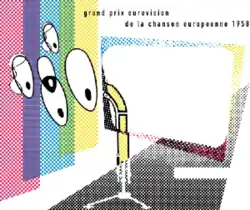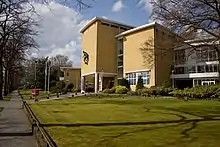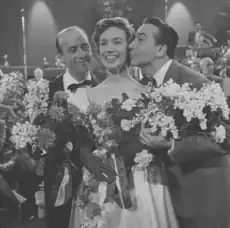Eurovision Song Contest 1958
The Eurovision Song Contest 1958 was the third edition of the annual Eurovision Song Contest. Organised by the European Broadcasting Union (EBU) and host broadcaster Nederlandse Televisie Stichting (NTS), the contest, originally known as the Grand Prix Eurovision de la Chanson Européenne 1958 (English: Grand Prix of the Eurovision Song Contest 1958[1]) was held on Wednesday 12 March 1958 at the AVRO Studios in Hilversum, the Netherlands and hosted by Dutch television presenter Hannie Lips. This marked the first time that the contest was hosted in the country of the preceding year's winner, a tradition that has been continued ever since (with some exceptions).
| Eurovision Song Contest 1958 | |
|---|---|
 | |
| Dates | |
| Final | 12 March 1958 |
| Host | |
| Venue | AVRO Studios Hilversum, Netherlands |
| Presenter(s) | Hannie Lips |
| Musical director | Dolf van der Linden |
| Directed by | Gijs Stappershoef |
| Executive producer | Piet te Nuyl Jr. |
| Host broadcaster | Nederlandse Televisie Stichting (NTS) |
| Website | eurovision |
| Participants | |
| Number of entries | 10 |
| Debuting countries | |
| Non-returning countries | |
Participation map
| |
| Vote | |
| Voting system | Ten-member juries in each country; each member gave one vote to their favourite song |
| Winning song | "Dors mon amour" |
Ten countries participated, equalling the number which took part the previous year; Sweden made its first appearance in the contest, while the United Kingdom decided not to participate.
The winner of the contest was France, represented by the song "Dors mon amour" performed by André Claveau, marking the first of five eventual wins for the country. Another entry however made a greater impact following the contest; the Italian entry, "Nel blu, dipinto di blu" performed by Domenico Modugno which had placed third, became a worldwide hit for Modugno, winning two Grammy Awards in 1959 and becoming a chart success in several countries.
Location

The 1958 contest took place in Hilversum, the Netherlands. The selected venue was the AVRO Studios, which served at the time as the main radio and television broadcasting facilities of the Dutch broadcaster AVRO.[2][3] Often called "media city", Hilversum is the principal centre for radio and television broadcasting in the Netherlands and is the location of several of the organisations that make up the Nederlandse Publieke Omroep (NPO) public broadcasting organisation.[4][5]
Although they had won in 1957, the Netherlands' did not receive automatic rights to host the contest, as the convention in place at the time specified that each broadcaster would stage the event in turns.[6] The British Broadcasting Corporation (BBC) had been the first choice to stage the event in the United Kingdom, but gave up the rights after failing to reach agreement with artistic unions.[7] Subsequently the Dutch broadcaster, Nederlandse Televisie Stichting (NTS), only received the rights to host the event after other broadcasters declined the opportunity.[6][8][9] This established the tradition that the previous year's winner would host it the following year.[10][11]
Participating countries
Ten countries participated in the 1958 contest, the same number as had featured in the previous year's event. Sweden entered the contest for the first time, while the United Kingdom decided not to compete, despite having originally intended to participate and being listed as one of the participating countries in the original rules dated November 1957.[2][7][10]
Several of the participants had previously competed in the contest. Switzerland's Lys Assia and the Netherlands' Corry Brokken had both represented their countries in 1956 and 1957, and were both former winners; Assia was the first winner of the contest in 1956 with the song "Refrain", and had also performed Switzerland's other entry in that contest "Das alte Karussell", while Brokken had performed "Voorgoed voorbij" in the 1956 contest, one of the Netherlands' two entries, and was then the winner the following year with the song "Net als toen".[12][13] Belgium's Fud Leclerc had also competed in the 1956 contest, performing "Messieurs les noyés de la Seine", one of his country's two entries, and Margot Hielscher returned to perform for Germany for a second year in a row, having competed in 1957 with "Telefon, Telefon".[12][13]
| Country | Broadcaster | Artist | Song | Language(s) | Songwriter(s) | Conductor |
|---|---|---|---|---|---|---|
| ORF | Liane Augustin | "Die ganze Welt braucht Liebe" | German |
|
Willy Fantl | |
| INR | Fud Leclerc | "Ma petite chatte" | French | André Dohet | Dolf van der Linden | |
| Statsradiofonien | Raquel Rastenni | "Jeg rev et blad ud af min dagbog" | Danish | Harry Jensen | Kai Mortensen | |
| RTF | André Claveau | "Dors mon amour" | French | Franck Pourcel | ||
| WDR[lower-alpha 1] | Margot Hielscher | "Für zwei Groschen Musik" | German |
|
Dolf van der Linden | |
| RAI | Domenico Modugno | "Nel blu, dipinto di blu" | Italian | Alberto Semprini | ||
| CLT | Solange Berry | "Un grand amour" | French |
|
Dolf van der Linden | |
| NTS | Corry Brokken | "Heel de wereld" | Dutch | Benny Vreden | Dolf van der Linden | |
| SR | Alice Babs | "Lilla stjärna" | Swedish |
|
Dolf van der Linden | |
| SRG SSR | Lys Assia | "Giorgio" | German, Italian |
|
Paul Burkhard |
Format
%252C_Bestanddeelnr_909-4008.jpg.webp)
The contest was organised and broadcast by NTS, with Piet te Nuyl Jr. serving as producer, Gijs Stappershoef serving as director, and Dolf van der Linden serving as musical director, leading the Metropole Orkest during the event.[19][20][21] Each country was allowed to nominate their own musical director to lead the orchestra during the performance of their country's entry, with the host musical director also conducting for those countries which did not nominate their own conductor.[15][17]
Held in one of the studios of the AVRO broadcasting complex, the hall contained a small stage for the singers, with the orchestra situated stage right. The rear of the performance area had interchangeable backgrounds for each song to add context to each song's lyrics, which could also be removed to show the scoreboard during the voting sequence, and the venue was decorated with thousands of tulips.[2][22]
No significant changes to the rules of the 1957 contest were implemented; each country, participating through one EBU member broadcaster, was represented by one song performed by up to two people on stage.[2][10] Due to several entries having violated the duration limit in the previous event, the maximum song limit of 3 minutes and 30 seconds was more stringently enforced for this year's entries.[6] The voting system was the same as the one used the previous year; the results were determined through jury voting, with each country's jury containing ten individuals who each gave one vote to their favourite song, with no abstentions allowed and with jurors unable to vote for their own country.[19]
Contest overview

%252C_Bestanddeelnr_909-4001_(cropped).jpg.webp)
The contest was held on 12 March 1958, beginning at 21:00 CET (20:00 UTC) with an approximate duration of 1 hour and 10 minutes.[23][24] The contest was hosted by Dutch presenter Hannie Lips.[2][15] A performance by the Metropole Orkest featured as the interval act between the final competing performance and the commencement of the voting results, which included a rendition of Cielito Lindo.[25] In addition, after the first five songs, the Metropole Orkest performed the "Wedding Dance" from the Symphonic Suite “Hasseneh” by Jacques Press as an interval act to give the juries a break to deliberate.[26]
During the live transmission of the contest several countries were unable to see or hear the Italian entry, which was the first act to perform, due to a technical fault, and it was subsequently allowed to perform again after the last song.[9][15][27]
The winner was France represented by the song "Dors mon amour", composed by Pierre Delanoë, written by Hubert Giraud and performed by André Claveau.[28] This was the first of an eventual five contest victories that France would go on to achieve.[29]
The Italian entry, "Nel blu, dipinto di blu" performed by Domenico Modugno, went on to become a worldwide success, and was one of the first Eurovision songs to achieve notability outside of the contest.[9] Popularly known as "Volare", the song went to number one in the US Billboard Hot 100, as well as reaching the top 5 in singles charts in Belgium, Canada, the Netherlands and Norway, and the top 10 in the United Kingdom, and was named Record of the Year and Song of the Year at the first edition of the Grammy Awards held in May 1959.[30][31][32][33][34] The song has been covered by several artists, including Dean Martin, Dalida and Gipsy Kings, and many new versions with lyrics in different languages have been produced.[35][36] "Nel blu, dipinto di blu" was also nominated in 2005 to compete in Congratulations: 50 Years of the Eurovision Song Contest, a special broadcast to determine the contest's most popular entry of its first 50 years as part of the contest's anniversary celebrations. One of 14 entries chosen to compete, "Nel blu, dipinto di blu" ultimately finished in second place behind "Waterloo", ABBA's winning song from the 1974 contest.[37][38]
| R/O | Country | Artist | Song | Points | Place |
|---|---|---|---|---|---|
| 1 | Domenico Modugno | "Nel blu, dipinto di blu" | 13 | 3 | |
| 2 | Corry Brokken | "Heel de wereld" | 1 | 9 | |
| 3 | André Claveau | "Dors mon amour" | 27 | 1 | |
| 4 | Solange Berry | "Un grand amour" | 1 | 9 | |
| 5 | Alice Babs | "Lilla stjärna" | 10 | 4 | |
| 6 | Raquel Rastenni | "Jeg rev et blad ud af min dagbog" | 3 | 8 | |
| 7 | Fud Leclerc | "Ma petite chatte" | 8 | 5 | |
| 8 | Margot Hielscher | "Für zwei Groschen Musik" | 5 | 7 | |
| 9 | Liane Augustin | "Die ganze Welt braucht Liebe" | 8 | 5 | |
| 10 | Lys Assia | "Giorgio" | 24 | 2 |
Spokespersons
Each country nominated a spokesperson who was responsible for announcing the votes for their respective country via telephone.[40] Known spokespersons at the 1958 contest are listed below.
Detailed voting results

The announcement of the results from each country was conducted in reverse order to the order in which each country performed.[19]
| Italy | 13 | 1 | 1 | 4 | 4 | 1 | 1 | 1 | |||
|---|---|---|---|---|---|---|---|---|---|---|---|
| Netherlands | 1 | 1 | |||||||||
| France | 27 | 1 | 7 | 1 | 1 | 9 | 1 | 1 | 6 | ||
| Luxembourg | 1 | 1 | |||||||||
| Sweden | 10 | 3 | 1 | 1 | 3 | 2 | |||||
| Denmark | 3 | 1 | 1 | 1 | |||||||
| Belgium | 8 | 1 | 5 | 1 | 1 | ||||||
| Germany | 5 | 1 | 1 | 1 | 2 | ||||||
| Austria | 8 | 2 | 1 | 1 | 1 | 3 | |||||
| Switzerland | 24 | 2 | 4 | 5 | 3 | 6 | 4 | ||||
Broadcasts
Each participating broadcaster was required to relay the contest via its networks. Non-participating EBU member broadcasters were also able to relay the contest as "passive participants".
No official accounts of the viewing figures are known to exist. In his introductory remarks, the Dutch commentator stated that a total number of "about 25 million viewers" across Europe could be estimated.[26]
Broadcasters were able to send commentators to provide coverage of the contest in their own native language and to relay information about the artists and songs to their television viewers.[45] Known details on the broadcasts in each country, including the specific broadcasting stations and commentators are shown in the tables below.
| Country | Broadcaster | Channel(s) | Commentator(s) | Ref(s) |
|---|---|---|---|---|
| ORF | ORF | [46] | ||
| INR | INR | [47][48] | ||
| Radio Belgique | ||||
| NIR | NIR | [47] | ||
| Statsradiofonien | Statsradiofonien TV, Program 1 | Svend Pedersen | [49][50] | |
| RTF | RTF | Pierre Tchernia | [24][51] | |
| France I | [48] | |||
| ARD | Deutsches Fernsehen | [24][47] | ||
| RAI | Programma Nazionale, Secondo Programma | Bianca Maria Piccinino | [48][52] | |
| CLT | Télé-Luxembourg | [53] | ||
| NTS | NTS | Siebe van der Zee | [23][47] | |
| NRU | Hilversum 1 | [47] | ||
| SR | Sveriges TV | Jan Gabrielsson | [42] | |
| SRG SSR | TV DRS | [24][48] | ||
| TSR, RSR 2 | Georges Hardy | |||
| DRS 2 | ||||
| RSI |
| Country | Broadcaster | Channel(s) | Commentator(s) | Ref(s) |
|---|---|---|---|---|
| BBC[lower-alpha 2] | BBC Television Service | Peter Haigh | [1][15] |
Notes and references
Notes
References
- "Television Programmes – Sunday Afternoon". Radio Times. 16 March 1958. p. 12. Retrieved 5 June 2022.
- "Hilversum 1958 – Eurovision Song Contest". European Broadcasting Union. Archived from the original on 30 May 2022. Retrieved 6 June 2022.
- "Former AVRO-studio". Dudok Architectuur Centrum. Archived from the original on 6 June 2022. Retrieved 6 June 2022.
- LaFleur, Louise (6 September 2019). "How the Netherlands hosts the Eurovision Song Contest". European Broadcasting Union. Archived from the original on 15 April 2020. Retrieved 6 June 2022.
- "About Hilversum". Gemeente Hilversum. Archived from the original on 8 March 2022. Retrieved 6 June 2022.
- Escudero, Victor M. (26 October 2017). "#ThrowbackThursday to 60 years ago: Eurovision 1957". European Broadcasting Union. Archived from the original on 2 January 2018. Retrieved 3 June 2022.
- Jordan, Paul; Roxburgh, Gordon (11 January 2017). "Shining a light on the United Kingdom: 60 Years at Eurovision". European Broadcasting Union. Archived from the original on 24 April 2017. Retrieved 31 May 2022.
- "Looking back to just like it was in 1957". European Broadcasting Union. 3 March 2014. Archived from the original on 13 May 2018. Retrieved 3 June 2022.
- O'Connor, John Kennedy (2010). The Eurovision Song Contest: The Official History (2nd ed.). London, United Kingdom: Carlton Books. pp. 12–13. ISBN 978-1-84732-521-1.
- Roxburgh, Gordon (2012). Songs for Europe: The United Kingdom at the Eurovision Song Contest. Vol. One: The 1950s and 1960s. Prestatyn, United Kingdom: Telos Publishing. p. 160. ISBN 978-1-84583-065-6.
- "How it works – Eurovision Song Contest". European Broadcasting Union. 15 January 2017. Archived from the original on 31 May 2022. Retrieved 4 June 2022.
- "Participants of Lugano 1956 – Eurovision Song Contest". European Broadcasting Union. Archived from the original on 26 October 2021. Retrieved 9 June 2022.
- "Participants of Frankfurt 1957 – Eurovision Song Contest". European Broadcasting Union. Archived from the original on 9 October 2021. Retrieved 9 June 2022.
- "Participants of Hilversum 1958". European Broadcasting Union. Archived from the original on 1 April 2023. Retrieved 9 June 2023.
- Roxburgh, Gordon (2012). Songs for Europe: The United Kingdom at the Eurovision Song Contest. Vol. One: The 1950s and 1960s. Prestatyn, United Kingdom: Telos Publishing. pp. 160–164. ISBN 978-1-84583-065-6.
- "1958 – 3rd edition". diggiloo.net. Archived from the original on 22 March 2022. Retrieved 9 June 2022.
- "Detailed overview: conductors in 1958". And the conductor is... Retrieved 1 July 2022.
- "Alle deutschen ESC-Acts und ihre Titel". www.eurovision.de (in German). ARD. Archived from the original on 12 June 2023. Retrieved 12 June 2023.
- Roxburgh, Gordon (2012). Songs for Europe: The United Kingdom at the Eurovision Song Contest. Vol. One: The 1950s and 1960s. Prestatyn, United Kingdom: Telos Publishing. pp. 164–166. ISBN 978-1-84583-065-6.
- O'Connor, John Kennedy (2010). The Eurovision Song Contest: The Official History (2nd ed.). London, United Kingdom: Carlton Books. p. 217. ISBN 978-1-84732-521-1.
- "Europa's zangsterren schraapten de keel" [Europe's singing stars cleared their throats]. De Volkskrant. 12 March 1958. p. 3. Retrieved 26 June 2023 – via Delpher.
- Zwart, Josianne (4 November 2017). "A decade of song: Eurovision winners through the years (1956-1959)". European Broadcasting Union. Archived from the original on 4 November 2017. Retrieved 7 June 2022.
- "Hilversum in actie voor 70 minuten Eurovisie". Nieuwe Leidsche Courant. 10 March 1958. p. 5. Retrieved 11 June 2021.
- "Télévision". Radio – Je vois tout (in French). Lausanne, Switzerland: Héliographia SA. 5 March 1958. pp. 22–23. Retrieved 5 June 2022 – via Scriptorium Digital Library.
- O'Connor, John Kennedy (2010). The Eurovision Song Contest: The Official History (2nd ed.). London, United Kingdom: Carlton Books. p. 216. ISBN 978-1-84732-521-1.
- Grand Prix Eurovision de la Chanson Européenne 1958 (Television programme) (in Dutch). Hilversum, The Netherlands: NTS. 12 March 1958.
- Escudero, Victor M. (2 September 2017). "Ciao Italia! Top 10 entries from Italy". European Broadcasting Union. Archived from the original on 3 September 2017. Retrieved 9 June 2022.
- "André Claveau – France – Hilversum 1958". European Broadcasting Union. Archived from the original on 22 April 2022. Retrieved 18 July 2022.
- "France – Country Profile". European Broadcasting Union. Archived from the original on 5 June 2022. Retrieved 10 June 2022.
- "Domenico Modugno – Nel blu dipinto di blu". dutchcharts.nl. Archived from the original on 10 March 2021. Retrieved 10 June 2022.
- "CHUM Hit Parade Chart: Week of August 25, 1958". CHUM Hit Parade. Archived from the original on 7 April 2022. Retrieved 10 June 2022.
- "Domenico Modugno | Full Official Chart History". Official Charts Company. Archived from the original on 28 January 2021. Retrieved 10 June 2022.
- "1st Annual Grammy Awards | 1958". Grammy Awards. Retrieved 10 June 2022.
- "Billboard Hot 100 – Week of August 18, 1958". Billboard. Archived from the original on 29 June 2021. Retrieved 10 June 2022.
- "Volare | full Official Chart History | Official Charts Company". Official Charts Company. Archived from the original on 12 July 2022. Retrieved 13 September 2022.
- "Eurovision : ces chansons sont devenues des tubes". Paris Match (in French). 26 April 2021. Archived from the original on 11 August 2022. Retrieved 13 September 2022.
- ""Congratulations" – 14 songs to compete". European Broadcasting Union. 16 June 2005. Archived from the original on 28 August 2005. Retrieved 10 June 2022.
- "Abba win 'Eurovision 50th' vote". BBC News. 23 October 2005. Archived from the original on 10 June 2022. Retrieved 10 June 2022.
- "Final of Hilversum 1958 – Eurovision Song Contest". European Broadcasting Union. Archived from the original on 5 June 2021. Retrieved 22 June 2021.
- "How it works – Eurovision Song Contest". European Broadcasting Union. 18 May 2019. Archived from the original on 31 May 2022. Retrieved 4 June 2022.
- 3ème Concours Eurovision de la chanson 1958 [3rd Eurovision Song Contest 1958] (Television broadcast) (in French). Radiodiffusion-Télévision Française and Nederlandse Televisie Stichting. 12 March 1958. Retrieved 26 June 2023 – via Institut national de l'audiovisuel.
- Thorsson, Leif; Verhage, Martin (2006). Melodifestivalen genom tiderna : de svenska uttagningarna och internationella finalerna (in Swedish). Stockholm: Premium Publishing. pp. 14–15. ISBN 91-89136-29-2.
- "Results of the Final of Hilversum 1958 – Eurovision Song Contest". European Broadcasting Union. Archived from the original on 27 March 2021. Retrieved 27 March 2021.
- "Eurovision Song Contest 1958 – Scoreboard". European Broadcasting Union. Archived from the original on 22 July 2015. Retrieved 14 June 2021.
- "The Rules of the Contest | Eurovision Song Contest". European Broadcasting Union. Archived from the original on 14 April 2017. Retrieved 13 September 2022.
- "Austria – Hilversum 1958". European Broadcasting Union. Archived from the original on 13 May 2018. Retrieved 13 September 2022.
- "Programma's Binnen- en Buitenlandse Zenders". De Telegraaf (in Dutch). 11 March 1958. p. 9. Retrieved 5 June 2022.
- "Programmes des Émissions Suisses et Étrangères". Radio – Je vois tout (in French). Lausanne, Switzerland: Héliographia SA. 6 March 1958. pp. 38–40. Retrieved 5 June 2022 – via Scriptorium Digital Library.
- "Programoversigt – Fjernsyn – 12-03-1958" (in Danish). Dansk Kulturarv. 12 March 1958. Archived (PDF) from the original on 5 June 2022. Retrieved 5 June 2022.
- "Programoversigt – Program 1 – 12-03-1958" (in Danish). Dansk Kulturarv. 12 March 1958. Archived (PDF) from the original on 5 June 2022. Retrieved 5 June 2022.
- "La carrière de Pierre Tchernia résumée en dix moments clés". Le Soir (in French). 8 October 2016. Archived from the original on 5 June 2022. Retrieved 5 June 2022.
- "Oggi e domani alla radio". La Stampa (in Italian). 12 March 1958. p. 8. Retrieved 2 June 2022.
- "Télé-Luxembourg". Luxemburger Wort (in German and French). 11 March 1958. p. 4. Retrieved 6 November 2022.
